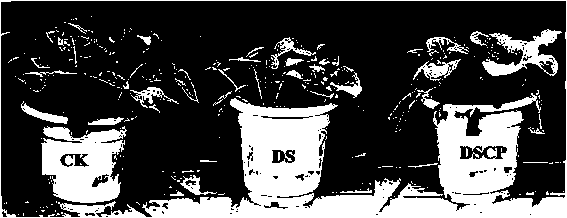New method for improving drought resistance of brassica napus
A technology of drought resistance and a new method, applied to the field of agricultural cultivation, can solve problems such as difficulty in obtaining a drought resistance effect, and achieve the effects of improving drought resistance, improving drought resistance and low cost.
- Summary
- Abstract
- Description
- Claims
- Application Information
AI Technical Summary
Problems solved by technology
Method used
Image
Examples
Embodiment 1
[0015] Pure Brassica napus seeds were selected and treated with a low-temperature plasma processor. The treatment parameters were as follows: the treatment power was 300 W, the treatment time was 15 s, the treatment pressure was 150 Pa, and the distance between the plates was 4 cm. After the low-temperature plasma treatment, the seeds were placed in an incubator at 25°C to accelerate germination, and the seeds were sown in pots after the seeds turned white. Apply 0.12 g / kg urea, 0.12 g / kg potassium chloride, 0.34 g / kg superphosphate and 6 mg / kg borax to the soil. When the seedlings grew to the five-leaf one-heart stage (40 days after sowing), the drought stress treatment was carried out. After the treatment, the drought-resistant agent mixture (5-aminolevulinic acid 50 mg / L, hydrogen concentration 0.05mmol / L of hydrogen-rich water, boric acid 1 g / L, Tween-80 0.1%) 25 ml, and the roots were perfused with 25 ml of drought-resistant agent mixture.
[0016] Through low-temperatu...
Embodiment 2
[0020] Pure Brassica napus seeds were selected and treated with a low-temperature plasma processor. The treatment parameters were as follows: the treatment power was 350 W, the treatment time was 60 s, the treatment pressure was 100 Pa, and the distance between the plates was 2 cm. After the low-temperature plasma treatment, the seeds were placed in an incubator at 25°C to accelerate germination, and the seeds were sown in pots after the seeds turned white. Apply 0.12 g / kg urea, 0.12 g / kg potassium chloride, 0.34 g / kg superphosphate and 6 mg / kg borax to the soil. When the seedlings grow to the five-leaf one-heart stage (40 days after sowing), the drought stress treatment is carried out. After the treatment, the drought-resistant agent mixture (5-aminolevulinic acid 75 mg / L, hydrogen concentration 0.1 mmol / L of hydrogen-rich water, boric acid 2 g / L, Tween-80 0.2%) 25 ml, and at the same time, the roots were perfused with 25 ml of drought-resistant agent mixture.
[0021] Thro...
Embodiment 3
[0025] Pure Brassica napus seeds were selected and treated with a low-temperature plasma processor. The treatment parameters were as follows: the treatment power was 450 W, the treatment time was 90 s, the treatment pressure was 50 Pa, and the distance between the plates was 3 cm. After the low-temperature plasma treatment, the seeds were placed in an incubator at 25°C to accelerate germination, and the seeds were sown in pots after the seeds turned white. Apply 0.12 g / kg urea, 0.12 g / kg potassium chloride, 0.34 g / kg superphosphate and 6 mg / kg borax to the soil. When the seedlings grew to the five-leaf one-heart stage (40 days after sowing), the drought stress treatment was carried out. After the treatment, the drought-resistant agent mixture (including 5-aminolevulinic acid 100 mg / L, hydrogen concentration of 0.2 mmol / L of hydrogen-rich water, boric acid 3 g / L, Tween-80 0.3%) 25 ml, and at the same time, the roots were perfused with 25 ml of drought-resistant agent mixture. ...
PUM
 Login to View More
Login to View More Abstract
Description
Claims
Application Information
 Login to View More
Login to View More - R&D
- Intellectual Property
- Life Sciences
- Materials
- Tech Scout
- Unparalleled Data Quality
- Higher Quality Content
- 60% Fewer Hallucinations
Browse by: Latest US Patents, China's latest patents, Technical Efficacy Thesaurus, Application Domain, Technology Topic, Popular Technical Reports.
© 2025 PatSnap. All rights reserved.Legal|Privacy policy|Modern Slavery Act Transparency Statement|Sitemap|About US| Contact US: help@patsnap.com



